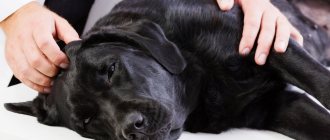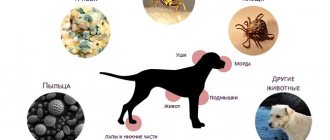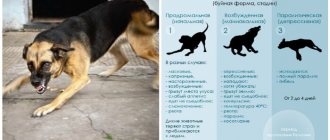One of the indicators of an animal’s health is normal feces of standard color and consistency. Dog owners should be aware that when eating portioned food per day, a dog can produce up to one hundred and fifty grams of feces (of course, the figure will vary depending on the size and weight of the pet).
However, sometimes dog owners have to deal with the fact that their pet defecates not at all healthy brown feces, but, on the contrary, abnormal black feces. You should know that black feces in a dog are, first of all, a sign of the presence of blood in waste products, which, in turn, is a symptom of many dangerous diseases.
In general, blood in feces comes in two colors, namely light scarlet and dark burgundy, very close to black. And if in the first case bleeding occurs either closer to the anus or in the large intestine (which is why it does not have time to be digested and retains its natural red color), then black digested blood in the pet’s excrement always indicates bleeding in the digestive tract and small intestine. And this, in turn, means that the likelihood of damage to internal organs is extremely high.
That is why pet owners should take such discharge very seriously and immediately contact a veterinarian.
Black feces or even diarrhea (which can be considered an additional clinical sign) should cause great concern among dog owners, since the list of reasons that can provoke such a symptom is replete with quite severe and extremely serious diseases, such as:
· Parvovirus enteritis, which is an infectious disease with a very rapid development cycle. Only dogs suffer from enteritis. Young animals with weakened immune systems are especially at risk of becoming infected. This disease has a number of clinical signs, including black feces in dogs. To differentiate enteritis from other diseases accompanied by the same symptom will help to know that blood inclusions do not form a homogeneous mixed mass with feces, but come out in small clots.
· Stomach ulcer, which is usually also accompanied by internal gastrointestinal bleeding. It should be noted that blood can be seen not only in the animal’s feces, but also in the vomit, which will be a sign of active progression of the disease.
· Hemorrhagic gastroenteritis is a disease that is essentially inflammation of the stomach and intestines. Most often, small pets of decorative breeds suffer from this disease. Among the main clinical signs, experts identify severe vomiting and black feces in the dog. Unfortunately, to date, scientists have not been able to completely determine the cause of this disease. However, most of them agree that gastroenteritis may well be caused by severe stress, complications of certain infectious diseases or circulatory disorders.
· Entry of a foreign object into the animal's body. A foreign body entering the stomach may well damage the walls of the gastrointestinal tract. The likelihood of such an incident is especially high if the object is hard and sharp. Thus, by damaging the mucous membrane, a foreign object provokes internal bleeding, the volume of which will only increase over time.
Black feces are a symptom of many diseases, and that is why experts usually insist on carrying out certain diagnostic measures that can clarify the situation. As a rule, their list includes: a clinical examination of the dog, ultrasound of the internal organs of the gastrointestinal tract, three types of stool analysis (in addition to the general analysis, the presence of infections and protozoa is checked), as well as gastroscopy.
Of course, there is no universal panacea for all diseases that can provoke internal bleeding in the stomach and intestines. That is why therapy is prescribed only after diagnosis. Remember, under no circumstances should you try to treat the dog yourself: firstly, it is unlikely to work for recovery, and secondly, you can only aggravate the situation, delay the start of treatment and complicate the differentiation of the disease - the root cause. Thus, the only correct step that an owner can take when this symptom is detected is to immediately show their pet to the attending physician.
The normal color of feces in dogs and cats is considered to be dark to light brown. Black stool is most often not a sign of normality, so it should always alert you and prompt you to visit a veterinarian to determine the cause.
Physiological reasons
If the animals feel satisfactory, they have preserved their appetite and general cheerful state, then we can assume that blackening of the feces does not mean anything terrible:
- perhaps pets are given iron supplements or vitamin and mineral supplements with it;
- pets are fed raw meat, and a large amount of blood meal with black licorice is added to the diet.
Signs of pathologies
The main reason for the darkening of animal feces is the ingress of blood into them. This condition may be a symptom of some disease, and black feces occur in dogs for the same reasons as in cats:
If, along with blackening of the stool in a cat or dog, the following signs are noted, this is already a reason to go to the veterinarian immediately:
- against a black background, obvious red blood clots are noted - this is a sign of severe open bleeding, in any part of the intestines or stomach;
- the animal has a stomach ache (you can hear whining or a plaintive meow, there may be a slight trembling in the body; when trying to stroke or feel the stomach, the animal seems to try to move away);
- increased body temperature (above 38.5°C in mustachioed pets and more than 39°C in dogs when measured rectally);
- stools are black and runny (melena), there is vomiting (especially when there is blood in the vomit);
- lethargic general condition, lack of playfulness, decreased appetite or complete refusal to eat.
In order to make an accurate diagnosis, you need to conduct a stool test for the presence or absence of occult blood. If the result is positive, then the veterinarian begins to determine the cause:
- performs an ultrasound of the abdomen;
- checking blood for clotting (coagulogram);
- does an x-ray and/or gastroscopy;
- Blood tests are required.
Treatment and help at home will not give results. Any therapeutic procedures should be carried out only after determining the cause of black stool.
First of all, it is necessary to use hemostatic drugs (the type of drug and its dosage is selected only by a veterinarian):
- vikasol 1% (about 75-90 rubles/pack of 10 amps): daily dose for cats – 1-2 mg/kg body weight, dogs – 1-3 mg/kg per muscle; Duration of use is from 3 to 5 days;
- etamsylate 12.5% or dicinone (up to 140 rubles/pack of 10 amps): intramuscularly 10-12 mg/kg (on average 0.1 ml/kg body weight) twice a day - up to 3 days;
- aminocaproic acid 5% (35-65 RUR/100 ml bottle): orally for both types of animals up to 5 times a day, 8-10 mg/kg. Give to dogs with caution, as... possible gastrointestinal irritation. Can be administered slowly intravenously at a rate of 1 ml/kg;
- tranexam (1100-1700 rubles/pack of 10 amps): 10-15 mg/kg intramuscularly or intravenously every 6-8 hours until the blood stops permanently.
After stopping the bleeding and determining its cause, the following is prescribed:
- antibiotic and antiviral therapy;
- carrying out deworming (treatment against worms);
- surgical intervention, with the help of which foreign traumatic objects or tumors are removed;
- mandatory nutritional correction;
- gastroprotectors.
Why does my dog/cat have black stool?
If there is black liquid stool and vomiting?
This condition is often observed during poisoning (for example, rat poison). It is necessary to soberly assess the surrounding situation and try to understand what the animal might have eaten. Take your pet to a veterinarian for first aid, because... This condition is characterized by internal bleeding and can cost him his life.
After taking what medications can stool turn black?
The feces will turn black if the dog or cat is given iron supplements or any vitamin and mineral supplements with iron. In this case, this condition is considered normal and will go away immediately after these medications and supplements are no longer given.
Black feces are detected and the animal does not eat anything
Lack of appetite in a cat/dog accompanied by blackened stool is definitely a sign of ill health. What kind of pathology is and what its cause can only be determined by a veterinary specialist - it is better to take the animal to the veterinarian.
Black feces before the death of an animal
In a state of death agony, relaxation of all physiological sphincters and involuntary emptying of the colon can be observed. Moreover, against the background of dysfunction and failure of internal organs, feces may change color to a darker one. This phenomenon can be observed in everyone.
Brown-black cat feces with an unpleasant odor
Most likely, a mustachioed pet has indigestion or gastric stagnation. The food stagnates in it and begins to literally rot. The unpleasant odor that accompanies dark feces is reminiscent of the specific smell of rotting meat. You should contact a specialist to start the proper functioning of the gastrointestinal tract and populate it with beneficial bacteria.
Hello! The dog is 9 years old, weight 30-35 kg. After eating, 1-2 hours later he vomits food and mucus, the stool is dark, the nose is cold, the dog is weak. The dog is angry, sitting on a chain. It’s very difficult to invite a doctor; the dog won’t let you in; taking you to a doctor is the same. What to do? Please tell me.
Journey through the dog's digestive tract
Since we're talking about feces, which is technically the end result of a physiological process known as digestion, we need to take a close look at the path of any given type of food through the gastrointestinal tract, since the color of a dog's poop depends on what happens somewhere along the way.
The digestive tract is a very long tube that starts in the mouth and ends in the anus. This is a contiguous tract, and between the esophagus and the duodenum of the small intestine there will be only one major outlet, forming a pouch-like structure known as the stomach.
When food enters a dog's mouth, it travels down the esophagus and into the stomach, where a whole bunch of stomach fluids try to chug, digest, and break down all the different food molecules into smaller pieces in preparation for final digestion and absorption in the small intestine. The food then passes through the duodenum—the first section of the small intestine—where it is filled with juices from the liver, gallbladder, and pancreas to ensure that all macromolecules of the food's nutrients are properly digested for absorption.
© shutterstock
The gallbladder secretes bile, a greenish substance that facilitates the processing of fat by various digestive enzymes. There are other enzymes and digestive fluids from the pancreas and liver, each of which adds additional color to the food. Food passes the entire length of the small intestine—the jejunum and the cecum—until it reaches the large intestine. By this time, water and other substances are constantly being reabsorbed by the body, forming a harder mass that we now call stool or feces. When nature demands, this stool is passed through the rectum and exits the anus.
Brown and well formed
This is generally considered a normal stool color in dogs. The brownish tint occurs due to the yellowing of bilirubin, a substance present in bile. This is the same substance that gives skin a slightly brownish to pinkish hue. Do not confuse this with jaundice, as this is due to increased bilirubin in the bloodstream. As long as your dog's brown stool doesn't show any additional colors, such as streaks of red or yellow, you should be happy that your pet is fine. In addition, it must be correctly formed. It may be brown, but if it is more watery than usual, that is also abnormal.
Red or brown with red veins
Any reddish color to a dog's stool always indicates active bleeding in the lower gastrointestinal tract, usually limited to the large intestine, rectum, or even the internal structures of the anus. This is different from bleeding in the small intestine because this structure is actually several feet long. To give you an idea, a dog's small intestine alone can be 2.5 times the length of your dog's body. So if your dog's body length is around 50cm, you can expect his small intestine to be around 100cm in length. If the bleeding occurs anywhere in the duodenum, the time it takes to reach the rectum and anus will be long enough for it to harden or thicken. Since you see bright red streaks, the bleeding is occurring in the cecum or the colon itself. Other causes could be colitis, a colon tumor, a parasitic infection, or even an infection of the anal glands.
Black or resinous
This is the opposite of the color of a dog's stool, which has bright red streaks. Black or tarry stool is always a sign of upper gastrointestinal bleeding, such as from a stomach or duodenal ulcer. Given the exceptional length of the small intestine, blood in the stool will take significantly longer to solidify. By the time it passes through the rectum and anus, it will already be significantly curled up and you will no longer see the red spots. One of the leading causes of upper gastrointestinal bleeding in dogs is the consumption of certain medications, such as aspirin. Therefore, it is important to always consult with your veterinarian about the medications you plan to give your dog.
Medicines and dosage for diarrhea in dogs
The medications that a person takes for diarrhea are in most cases suitable for a four-legged family friend, even a puppy. For complete treatment, you need to consult a veterinarian.
Loperamide
Loperamide and its analogues, which are offered by different manufacturers, come first. It is unlikely that a dog will happily eat such a bitter drug, so it needs to be crushed into powder, diluted with water and given to the animal.
A sick animal may resist such a tasteless method of treatment, so first we learn how to give the pill to a dog.
Dosage 0.05-0.1 mg per 0.5 kg of dog’s body weight. Give the medicine three times a day at intervals of 8 hours. Do not give loperamide for more than two days; this will lead to poisoning. This medication cannot be combined with other drugs of similar effect! This road leads to damage to the central nervous system.
An overdose will result in very persistent constipation, an apathetic or overexcited state, severe flatulence and even inflammation of the pancreas.
Smecta
Smecta is also one of the most common remedies for digestive disorders. Purified clay medicine safely and effectively absorbs toxins. The powder is mixed with water at a ratio of 1 to 3.
The dosage is simple: a sachet per animal three times a day. You can inject the suspension with a syringe without a needle, pouring a thin stream into the mouth. At the same time, you need to lightly massage your throat, causing swallowing movements.
This method of massaging the throat is suitable for all medicines that have an unpleasant taste.
Enterofuril
A product with an antibacterial effect helps in the fight against gram-positive and negative bacteria that cause digestive system disorders. The medication should not be given on an empty stomach; the dog needs to be fed a little before taking it.
The dosage is calculated at 2.5 ml per 1 kg of body weight. The medicine is taken calmly due to its sweet and mild taste.
Activated carbon
The most famous remedy for eating disorders in humans is just as effective in dogs. A tablet obtained through special processing of certain types of wood is an excellent therapeutic agent for diarrhea.
The dosage is simple: only 1 tablet per 1 kg of weight. The drug is diluted with water to a semi-liquid pulp and given with a syringe without a needle. You can give the medicine up to 4 times a day, but not after other medications. In this case, the effect of treatment may be reduced.
Levomycetin
In addition to classic chloramphenicol, there is also chloramphenicol stearate, which is convenient in veterinary medicine for intestinal disorders due to the action of bacteria. The tablet is crushed to a powder state, mixed with 15 ml of water and poured into the pet’s throat. Can be given using a syringe.
Furazolidone
It's better to choose another
medication, if there is such an option, since the effect of this particular medication is poorly tolerated by pets. Possible side effects include jaundice, renal failure, lethargy and central nervous system depression.
Dosage: 1 tablet per day once during the treatment period. The next day they switch to more gentle means.
White and chalky or brown with white speckles
If you see white specks in your dog's feces, these could be the eggs of certain intestinal parasites that have passed through the feces. However, if your dog's feces are whitish in color or perhaps even look chalky, then there is a high chance that your dog may be suffering from hypercalcemia, or a condition in which excessive amounts of calcium are released into the bloodstream. This can occur with bone fractures or any other type of bone injury because the calcium released by the bone matrix must be reabsorbed into the bloodstream.
© shutterstock
A dog has loose stools: how to treat it at home
In a situation where diarrhea lasts less than 2 weeks and there is no blood or mucus in the feces, self-treatment can be done. To do this you need to follow these steps:
- Stop feeding your pet. This diet should last 1-3 days.
- Give him as much drinking boiled water as possible.
- When your pet stops vomiting and he doesn’t run to the toilet so often, you can prepare rice water for him.
- In the subsequent diet, include only fermented milk products (give for about 3 days).
- Give him the Regidron solution.
- Prepare medicinal decoctions of plants such as sage, St. John's wort, blueberry or alder.
It is very important to monitor the animal’s body temperature. If it increases, then in this case you need to stop self-medication and immediately contact a veterinary clinic.
In the case of an infectious form of the disease that leads to the appearance of loose stools, antibiotic therapy is used. It is strictly forbidden to treat your pet with such strong drugs yourself!
If your pet suffers from traumatic intestinal injury, surgery will most likely be required. This procedure also cannot be performed at home.
Purple or pink
If you see what looks like raspberry jam in your dog's stool or that there is an unusual amount of blood passing through your pet's rectum and anus, this is often a sign of hemorrhagic gastroenteritis, or severe bleeding caused by inflammation of the small and large intestines. If you notice this type of feces on your dog, be sure to seek emergency veterinary care immediately. You must understand that thousands of dogs die every year due to hemorrhagic gastroenteritis, which can lead to massive blood loss, electrolyte imbalance, tissue hypoxia and death. However, with timely treatment, your dog can prevent disaster.
Consequences of diarrhea
The most dangerous thing for a dog is diarrhea with blood. If there is abundant bloody discharge in the feces, then you need to immediately call a specialist and not wait until the last moment. It is worth considering that in rare cases very terrible diseases, such as rabies, manifest themselves in this way.
We recommend reading: If After Vomiting a Cat Refuses to Eat?
Also, if an animal suffers from acute diarrhea and there is strange discharge in the feces, then this may indicate damage to the internal organs by some object. If measures are not taken in a timely manner, the animal may die from blood loss or disruption of internal organs.
Self-treatment of loose stool in a dog or ignoring problems can greatly affect the pet’s health, even to the point of death. Also, do not self-medicate if there is blood or mucus in the stool. However, in some cases, you can try to help your beloved pet yourself.
Grey
Remember what we said about how the brown color of dog stool is a function of bilirubin found in bile acids? Well, if there is not enough bilirubin or bile salts, your dog's feces will appear pale or grayish in color. Because bile salts are produced in the liver and stored in the gallbladder, the absence of bilirubin or bile salts in the stool may mean there is a problem in the liver or gallbladder. However, the most common culprit is an obstruction of the common duct, which is where the ducts from the liver, pancreas and gallbladder meet as they go to the duodenum, which drains fluids and enzymes. In such cases, if an obstruction is suspected, surgery to remove the obstruction may be required.
Harmless causes of white feces in dogs
Fortunately for the owner, the cause of white feces in a dog can be quite harmless. So, acholic stool also occurs in the following situations:
- The dog eats food with a high percentage of animal fats
: pork and lean beef, greasy trimmings, fatty sour cream and cheese. Such food in large quantities has a negative effect on the pancreas of animals; - Frequent or even constant feeding of the animal with bones.
A dog may have white feces after bones quite often, because systematically eating such hard and spicy foods has a negative impact on digestion in general and on the condition of the liver in particular. Typically, if an owner stops feeding their pet bones, the stool will return to its normal appearance (i.e., brown); - Taking (usually long-term) certain medications that affect liver function
(for example, Smecta for diarrhea or intestinal colic, the antibiotic Augmentin for treating joints or preventing infections after surgery, etc.).
It is also worth mentioning that many owners sound the alarm when they see only white specks in the feces of their pets (the color of the feces themselves is the usual - dark or light brown). These may be particles of undigested food. But in some situations, these white dots can also be parasitic worms!
Green
If you notice that your dog's poop has taken on a greenish tint, there's a good chance that he just likes your grassy lawn. Dogs are known to eat grass, especially if they have an upset stomach. So don't be surprised if you see greenish poop on your dog. Unfortunately, eating grass is not the only reason why your dog's poop may turn green. In some cases, this may be due to rat bait poisoning, a parasitic infection, or other gastrointestinal problems. The only thing you can do to identify grass-related green poop is to look for telltale signs of undigested grass or leaves. If you can't find one, then you'd better take your dog to the vet.
Causes and symptoms of diarrhea in dogs
- The most common cause of loose stools is a change in diet. It can be:
- spoiled products,
- a new product in the diet (sugar, raw eggs, onions, raisins, currants, nuts, legumes, carrots),
- too many products that weaken (kefir, yogurt, liver, offal, milk).
- Loose stools can be caused or the dog may have eaten something on the street.
- In puppies, loose stools occur simply from overeating.
The main symptom of diarrhea is loose stools, but there may be other signs that help determine the cause of the disease. For example, increased temperature, frequent urination, increased thirst, abdominal pain (the animal walks hunched over, prefers to lie down). Since a common cause of loose stools is problems with the gastrointestinal tract, it is not uncommon to observe such. It is important to observe the stool - its color, quantity, mucus or blood content.
What to do if your dog has loose stools: treating diarrhea
- If your puppy has loose stools, you should consult a veterinarian as soon as possible - this may be a symptom of a very dangerous viral disease.
- First of all, you need to stop feeding your dog anything for at least 12 hours, or preferably 24 hours.
- You can give her activated carbon at the rate of 1 tablet per 10 kg. At the same time, boiled water should always be available. The animal must be in a calm environment.
- For the first time after diarrhea, you can cook a little rice porridge with fish for your dog.
- If diarrhea does not start within 2 hours after eating, you can give some more food. The dog needs to be kept on this diet for a couple of days.
If diarrhea continues or if there are other dangerous signs of the disease, for example, blood in the stool, vomiting with foam, it is necessary to contact a veterinarian as soon as possible and take stool samples for analysis.
Monitoring the quality of a pet's feces is the responsibility of every owner. This is the only way you can notice violations in time and help him. Unfortunately, the dog itself cannot complain of abdominal pain and poor health. So, you need to proceed from what it can give you for diagnosis.
Possible causes of yellow feces in dogs
If your dog's stool is yellow in color, it is most likely due to his diet. Too fatty foods lead to digestive disorders and, as a result, changes in the color and consistency of stool. There is no need to often pamper your dog with fatty “snacks”, cottage cheese, butter, etc. If you have removed unwanted foods from your diet and the situation does not change, you need to contact your veterinarian.
Another, more serious reason, directly resulting from the first (poor nutrition), is associated with impaired liver and pancreas function. The dog probably has developed chronic, which is sluggish, or fermentative dyspepsia. If, in addition to the yellow color, the stool has a sharp sour smell, this only confirms the diagnosis.
Pasty yellow feces, in which there are obvious pieces of undigested food, it has a sour smell, bowel movements occur more than 2 times a day - this indicates a completely incorrect diet.
Basically, all causes of yellowing of feces are initially associated with systematically improper feeding of the dog. It is a big mistake to try to turn a natural carnivore into a vegetarian. The dog’s digestive system is adapted to digest meat, so it must be present in the diet.
There is no need to feed the dog only cereals and vegetables, low-quality proteins with cartilage, tendons and other connective tissue, fat, as well as vegetable protein, which is not at all absorbed in the dog’s gastrointestinal tract. This unnecessary load on the liver, which seeks to suppress fermentation processes in the stomach, gradually leads to the development of diseases.
White feces in a dog appear due to a malfunction in the internal organs. The animal's excrement should be brown or dark brown. The normal color is due to the fact that bile flows freely into the small intestine. It is important to note that bile is involved in the digestion of food. A dog's white stool appears when the flow of bile is disrupted and a large amount of this substance does not enter the small intestine. White feces in a pet should alert the owner. This problem may occur due to improper nutrition. However, in most cases, a dog's white stool is associated with illness. If such a problem is identified, you need to take your pet to the veterinarian!
Orange
You might think that yellowish colored dog stool is a sign that they ate too much carrots or pumpkin, but in fact it is a possible indication of gallbladder or liver problems. There may be too much bilirubin in the stool, causing it to appear more orange than normal brown. However, most often, orange-colored stools are watery, reminiscent of diarrhea. Therefore, if you see stool of this color in your dog, it is best to consult a veterinarian.
Yellow
If you notice a yellowish-orange color in your dog's stool, there is a chance that it is due to bile duct or liver problems, as we mentioned above. The only way to be sure of a possible connection with liver or biliary problems is to compare it with other clinical data. For example, if you also notice yellowing of your dog's conjunctiva, as well as the mucous membranes of the eyelids and the inside of the lips, then there is a possibility of liver disease, possibly hepatitis. This leads to an abnormal accumulation of freely circulating bilirubin in the blood, which eventually ends up in the stool, giving it a bright yellow or orange hue.
© shutterstock
However, if yellowing of the stool cannot be confirmed by other clinical signs, and the stool itself is quite watery or slimy, you may be dealing with a food intolerance. Again, you must correlate this with other manifestations, as food intolerance in dogs almost always manifests itself as vomiting and abdominal pain.
Greyish with a greasy appearance
If your dog's stool is slightly grayish in color and really slimy, oily, or greasy, then your dog may have exocrine pancreatic insufficiency. They call it exocrine to distinguish it from the endocrine function of the pancreas, which is mainly its ability to produce and secrete insulin and glucagon to regulate the metabolism of carbohydrates and other substances in the body. The exocrine function of the pancreas is directly related to its ability to produce and secrete digestive enzymes such as lipases, amylases, and proteases, which digest fats, carbohydrates, and proteins, respectively.
We mentioned above that as food passes through the duodenum, it fills with fluids from the liver, gallbladder and pancreas. The gallbladder secretes bile salts into food so that the fat in food can be adequately coated. This makes them relatively easy to digest by pancreatic lipases. If there is a problem in either of these two mechanisms, or even both, then the fat contained in food is not digested properly and is not absorbed into the blood. Instead, these fats will pass through the intestines, rectum, and anus, causing oily or greasy stool.
Some of the most common conditions that can cause exocrine pancreatic insufficiency in dogs can include pancreatic cancer, cystic fibrosis, and even chronic pancreatitis. If the underlying problem is the release of bile salts, then possible causes may include gallstone formation and extensive liver damage.
Other potential canine conditions that can cause steatorrhea—fatty feces—include intestinal malabsorption secondary to giardiasis, inflammatory bowel disease, overgrowth or harmful bacteria, and even celiac disease, although the latter condition is very rare in dogs.
Patient Materials
This article does not constitute veterinary advice and does not exclude an appointment at a veterinary clinic. Here is information that will help you make the right decision in favor of providing quick and effective care to your pet. After all, it’s better to play it safe and consult with a specialist than to regret what you could have done and didn’t do.
We recommend reading: Cat's Paws
1. The volume of stool is larger than usual
The most common cause of increased stool volume is overfeeding. Perhaps you feed your dog dry food “by eye”. Weigh your dog and feed him as much food as the food manufacturer recommends. Make sure the main diet is a source of calories and any treats are kept to a minimum. If you feed your dog “from the table”, be aware that not all ingredients are suitable for the dog’s normal digestion. Sometimes changing your diet gradually by changing the source of protein and carbohydrates can be helpful.
2. Loose stools
There are many reasons why a dog may have loose stools. Some of the most common causes are overfeeding, sudden changes in diet, stress, and change in water source (especially for puppies).
Infectious causes may include:
- Bacterial infection – for example, Campylobacter, Salmonella;
- Viral infection – for example, parvovirus enteritis;
- Dysbacteriosis.
Parasitic causes may include:
- Helminthic infestation - for example, roundworms;
- Protozoal diseases - for example, giardiasis, isosporosis.
- Inflammatory bowel diseases;
- Exocrine pancreatic insufficiency;
- Intoxication;
- Pancreatitis;
- Foreign body in the intestine;
- Neoplasia (tumor);
- Protein-losing enteropathy.
This is by no means a complete list of possible causes. Be sure to consult with a specialist to identify and eliminate the root cause of the disease.
3. Rare bowel movements (constipation)
Some potential causes of constipation:
- Obstruction or partial obstruction of the intestine (for example, if the dog has swallowed a stone, toy, bone);
- Gastrointestinal obstruction or partial obstruction due to another cause (eg, tumor or polyps); sometimes the cause may be more serious than expected (for example, rectal abscesses, anal tumors, or prostate enlargement);
- Endocrine (hormonal) problems such as hypothyroidism;
- Worm infestation;
- Neurological problems (eg, spinal disorders, nerve damage from injury) causing a condition called megacolon. It is assumed that megacolon develops as a result of disruption of the conduction of nerve impulses from the spinal cord to the smooth muscles of the intestine. Megacolon is primarily a problem in cats, but it also occurs in dogs;
- Certain drugs (such as diuretics, antacids, opioids, and antihistamines).
Diet has a big impact on stool consistency. This depends on the amount of fiber in the diet. Therefore, one food that is ideal for one dog may not be suitable for another. Too much fiber in the diet can lead to diarrhea or, conversely, constipation; this is individual for each dog and depends on the specific case.
Fluid intake is another important condition. Constipation occurs when too much moisture is absorbed by the intestines from the feed. In such cases, increasing fluid intake may be beneficial. You can add water to dry food about 20-30 minutes before feeding or use canned food. Adding a small amount of oil to your diet may help relieve constipation. In addition, you can increase the frequency of meals up to 3 times a day, which leads to optimized activity and increased efficiency of the small intestine.
4. Presence of fresh blood in the stool
Small amounts of bright red blood may be a typical symptom of colitis. This occurs as a result of inflammation of the lining of the large intestine.
There are many reasons that cause colitis, ranging from improper feeding to infectious diseases. A large amount of blood may indicate a serious problem. Veterinary help should be sought immediately.
5. Black stool, dark blood in stool
Black stool containing dark blood is also known as melena. Melena indicates bleeding in the upper intestines or stomach. Veterinary help should be sought immediately.
6. Light (gray) or yellow stools
Yellow/gray or lighter than normal stools may be a sign of pancreatic disease, liver disease, or giardiasis.
7. Greenish stool
Greenish colored stool may indicate the presence of bile. Alternative causes are giardiasis, rat poison poisoning.
8. Presence of mucus in stool
A little mucus in the feces may be normal. The intestines produce mucus to provide lubrication and moisture. However, if the mucus is excessive, contains streaks of blood, or is accompanied by diarrhea, veterinary attention should be sought.
Infectious causes may include:
Ensuring “normal” stool color
Feeding your dog a quality diet should help prevent any fecal problems. Limiting your intake of human foods can also promote healthier digestion, even if these foods are generally considered safe. Keeping your home and premises free of trash, compost piles, parasites, vermin and other harmful objects, organisms and chemicals should also be an integral part of the best pet care. However, you should also keep your medications out of reach of pets.
The color of a dog's stool can tell us a lot about its feeding habits and how its body actually reacts to the substances it puts in its mouth. It is our responsibility as pet parents to understand these stool colors and what they really mean so we can know what to do next.
Author of the article : Olivia Williams.











